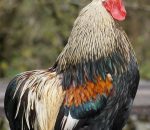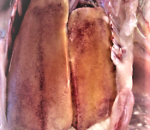Fowl pox is a contagious relatively slow-spreading, viral disease characterized by eruptions on various parts of unfeathered skin or diphtheritic lesions in the mucous membranes of the upper digestive and respiratory tracts. Fowl pox in chicken is caused by a DNA virus of the family Poxviridae.
The virus can be found in lesions and in desquamated scabs. It persists in the environment for several months. It is sensitive to lipid solvents, disinfectants, and heat.
Factors affecting susceptibility of birds
A. Skin abrasions or injuries
- Males of light breeds are more commonly affected because of their tendency to fight and cause skin damage.
- Birds having un-feathered skin areas are more commonly affected than well feathered birds.
- Disease is severe in the areas having high population of mosquitoes.
- Injuries in mouth and gut can also favour its occurance.
B. Age Factor
- Disease is less common in the young chicks than in the older birds.
- Mainly seen in birds of 5-12 months of age.
- May occur in broilers particularly in the summer season.
C. Stress and overcrowding increases the risk of transmission.
D. Parental immunity has no effect on susceptibility of the disease.
Pathogenesis
Infection commonly occurs through skin abrasions and bites (the virus cannot penetrate the intact skin or epithelial surface). Virus multiplies in the cytoplasm of the infected cells. The replication of viral DNA in dermal epithelium begins between 12 to 24 hours post-infection. The virus causes proliferation of the epithelium with ballooning of the cells forming papules or vesicles. Wart-like yellow-brown nodules develop due to hyperplasia. In terminal stages, nodules are converted to brown to black scabs.
Morbidity is 10 to 95% and mortality is usually low to moderate (0-50%).

Types of Fowl Pox
Recognized forms of fowl pox are following:
- Dry Pox (cutaneous form)
- Wet Pox (diphtheritic form)
- Oculo-nasal form
Clinical Signs/Manifestations
Dry Pox
- The mild form may remain unnoticed with only small focal lesions usually on the comb and wattles.
- Small bumps (wart-like lesions) form that remain moist for a short time but dry soon.
- In severe form, generalized lesions may occur on any part of the body ( wattles, comb, corner of the mouth, around the eyelids, angle of the beak, ventral surface of the wings legs, feet, vent).
- Papule —> vesicles —> pustules —> crust/scab —> scar
- Lesions often cause the complete or partial closure of one or both eyes.
- Removal of lesions leaves a completely dry or moist hemorrhagic surface. The mortality rate is usually low in cutaneous form or dry pox.

Wet Pox (diphtheritic form)
This form is associated with upper respiratory tract and the oral cavity.
- Caseous white patches are seen mucous membranes and they expand rapidly.
- Later on lesions become ulcerated and covered with a yelllowish caseouss necrotic exudate.
- The mucuos membranes undergo extensive fibrino-necrotic process and develop diphtheritic membrane.
- There is dyspnoea, gasping, and suffocation due to caseous material in the larynx. Death results from suffocation.
- Mortality is usually not significant unless there is respiratory involvement observed.
Oculo-nasal form
- Swelling of the eyes (conjunctivitis) and infra-orbital sinuses are common.
- This form is considered due to intercurrent infection.
Treatment and Prevention for Fowl Pox
There is no specific treatment for fowl pox as it is a viral disease.
Symptomatic treatment may reduce losses and shorten the course of the disease. For fowl pox treatment, use broad-spectrum antibiotics to check secondary bacterial infections. Antipyretic, anti-inflammatory drugs can be administered to reduce fever. Apply suitable antiseptic on skin lesions like tincture of iodine.
Reuduce environmental light intensity. Remove scabs around mouth and larynx, it will facilitate feeding and breathing.
For preventing fowl pox, we need to follow some guidlines. Dead birds must be burned or incinerated in order to avoid the spreadness of the causative virus. Adopt usual sanitary and disinfection procedures including the application of insecticides.
Fowl Pox Vaccination
Both cell-mediated immunity and humoral immunity play an important role in poxvirus infections. Birds recovered from the natural disease are immune. Vaccination in fowl pox is quite effective. Immunity develops within 10 days after vaccination.
Vaccination of broilers is not usually required unless mosquito population is high or infections have occured previously. All replacement chickens are vaccinated against fowl pox. One application of fowl pox vaccine results in permanent immunity.
If you find this content interesting and helpful then do like it and share this on your social media accounts. If you find any error or want to suggest any changing then do comment in comment box. Thanks for your time.


